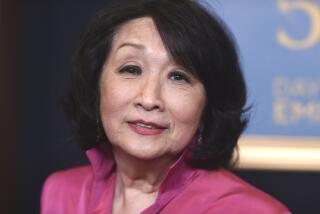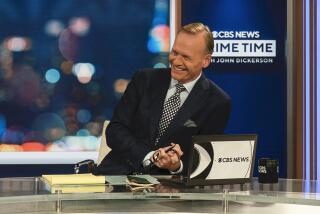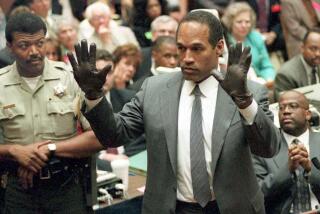Newscasts: What Isn’t in Picture : Television: The much-hyped pairing of CBS’ Chung and Rather draws attention away from the stark changes in network reporting.
- Share via
Good evening, I’m Connie Chung, sitting in for Dan Rather.
--From Monday’s finale of the “CBS Evening News With Dan Rather,” 24 hours prior to the premiere of the “CBS Evening News With Dan Rather & Connie Chung.”
The count.
On Tuesday, in their elbow-to-elbow debut as co-anchors of the “CBS Evening News,” Dan Rather was on camera alone for 231 seconds--more than half of that coming during the lead story on President Clinton’s miseries--and Connie Chung soloed for 134 seconds. Rather smiled six times during the 22-minute newscast, Chung eight.
On Wednesday, Rather got 217 seconds by himself, Chung 149. However, Chung still smiled the most, edging Rather 4-3.
Leading into Tuesday’s network newscast, KCBS-TV Channel 2 rolled out the obligatory welcome-Connie red carpet, repeatedly saying she was breaking “new ground” (as opposed to breaking previously broken ground) and interviewing school kids who agreed that teaming Rather with Chung--a woman!--was a terrific thing.
Channel 2 anchor Bree Walker said that viewers would now be able to judge that for themselves. And Hosea Sanders loyally added about former Channel 2 anchor Chung: “We have no doubt that she’ll do just fine . . . as she does with everything.”
Their hats were in the air, Chung’s hat was in the ring, and Rather--the dimming Bethlehem star of CBS News--had himself a gleaming partner.
In the blinding razzle-dazzle of publicity over the largely cosmetic Chung-Rather union, however, it was easy to forget some of the more profound changes occurring on the “CBS Evening News” and other network newscasts as a result of slashes in staff and other budget cutbacks.
On the maiden edition of the “CBS Evening News With Dan Rather & Connie Chung,” for example, the newscast’s two top international stories were narrated by CBS reporters who were not on the scene.
And on Wednesday, a major international story and a major domestic story were also narrated from long range.
Here was Chung’s introduction to Tuesday’s two-minute story on some soccer-playing Bosnians recently killed by mortar fire in that region’s civil war: “As David Martin reports, it was a grim reminder of the world’s failure to end the slaughter in Bosnia.” And a grim reminder of how networks increasingly are attempting to cut costs by having their reporters narrate significant foreign, and even some domestic stories, from afar.
In this case, national security correspondent Martin did a voice-over from New York that ran with pictures of the bloodshed in Bosnia. Viewers learned deep in the story that Martin wasn’t there when he appeared in a stand-up outside the United Nations building in New York.
Meanwhile, here was Rather’s introduction to Tuesday’s 90-second story about reaction to the murder of five Turks in Solingen, Germany: “The German government is scrambling for answers tonight, trying to prevent neo-Nazi hatred from careening the country into chaos. Angry protests followed a weekend firebombing that killed five Turkish immigrants. Correspondent Allen Pizzey is following events in the once-quiet city of Solingen.”
Following them from more than 500 miles away, it turned out.
Pictures from Solingen flashed on the screen, accompanied by Pizzey’s voice (“The police haven’t done enough, this German man says. . . . “). Later came his tag line: “Allen Pizzey, CBS News, London.”
Showing his versatility, London-anchored Pizzey on Wednesday was the primary voice on a story about violent anti-government protests in Belgrade.
And here was Chung’s introduction to a top domestic story Wednesday: “More reported victims, but still no answers about a mystery, flu-like illness that can kill. It was first discovered in the Southwest. But now fear is spreading to other parts of the country and so are suspected cases of the disease. Correspondent Sandra Hughes has an update.”
Hughes proceeded to read a script for the 90-second story (“The cause of the insidious disease that struck in and around the Navajo reservation remains a mystery tonight”) over pictures.
Then came her final six words, delivered from the bureau at Beverly and Fairfax: “Sandra Hughes, CBS News, Los Angeles.”
That there was no real deception by CBS News in any of these instances--the absence of on-the-scene correspondents was ultimately disclosed--did not alter the message that the way some news is covered by the networks has been quietly undergoing critical, perhaps irreversible change for the worse. The greater the distance between correspondent and story, the more difficult it is to examine issues insightfully, and the more likely that the reporting will be shallow. If there were no need to have reporters on the scene to examine things close up, then the networks would have done business that way from their inception.
Back to Martin, whose tag for Tuesday’s story on continuing bloodshed in the former Yugoslavia was as follows: “In Bosnia, the U.S. and its allies care more about coming up with a policy everyone can agree upon than one that might actually work.”
Whether Martin was correct was immaterial. The point was that this unattributed slam of the United States and its allies went beyond interpretation. Apparently it was Martin’s own opinion, the kind of crossover between reporting and editorializing that TV reporters are increasingly allowed to include in the tags of their stories. In an earlier era, purists worried about TV reporters and anchors conveying an opinion by something even as subtle as a raised eyebrow. Now that concern--and also the notion that reporting from the scene serves the public best--seem almost quaint.
Chung and Rather had some self-parodying fun at the end of their first newscast together. “Good night, Chet,” she said, turning to him. “Good night, David,” he said, turning to her.
Good night to lots of things.
More to Read
The complete guide to home viewing
Get Screen Gab for everything about the TV shows and streaming movies everyone’s talking about.
You may occasionally receive promotional content from the Los Angeles Times.






